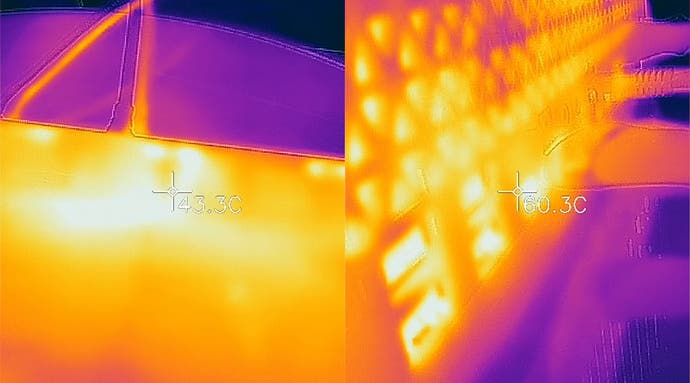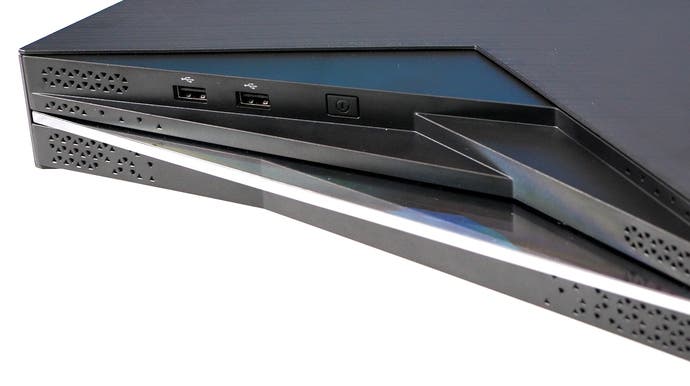Hands-on with the Subor Z-Plus: AMD tech tested in new Chinese console
How powerful is it - and how does it stack up against PS4 Pro?
AMD processors combining x86 CPUs and Radeon GPU technology have defined the current era of console gaming, but what if these small form factor boxes were wide-open devices, capable of running Windows 10 and PC games? And what if the under-powered Jaguar CPU cores were replaced with Ryzen instead for improved processing power? Last month, Chinese manufacturer Zhongshan Subor unveiled its Z Plus machine, which ticks all of those boxes - and I've spent the last week experimenting with an early production unit.
To date, all we've seen of the Z Plus is a render of the casing, some opportunistic motherboard shots and some 'guerrilla' photos of the machine on display at last month's ChinaJoy gaming event in China. First impressions of the actual unit in hand are very pleasant indeed - the packaging is slightly larger than a PS4 Slim retail box, and much smaller than the Pro. Breaking the three seals and opening up the package reveals hardware that is very console-like in nature: stacked vertically, the Z Plus is taller than the PlayStation 4 Pro but a good chunk thinner.
It's clear that a lot of thought has gone into its cooling too - vents are liberally deployed across the sides, rear and bottom of the unit while peering inside seems to reveal a very large heat sink. The design is somewhat more futuristic and industrial than the Sony and Microsoft consoles, with more than a nod given to its intended roles both as a PC and as a console. A brace of USB 2.0 ports are on the front, but on the back we get dual HDMI 2.0s, four USB 3.0 ports, gigabit Ethernet, Toslink, analogue audio and the power input. The Z Plus uses the same 'kettle' cable used by PS4 Pro and has a similar integrated 100-240v multi-voltage PSU.
Subor also deserves credit for system accessibility too. The Z Plus has an AMD SoC, meaning that the integrated CPU and GPU cannot be upgraded - and neither can the eight gigs of onboard GDDR5 memory. However, storage can be easily swapped out. A front section of the console is easily removed, giving you quick access to two 2.5-inch SATA drives. Our unit came with a 128GB SSD for the OS and a 1TB Toshiba mechanical drive - and both of them can be swiftly exchanged for superior storage solutions. It's considerably easier to work with than PS4 and Pro - and obviously Xbox doesn't let you upgrade internal storage at all.
| Subor Z-Plus | Kaby Lake G | Ryzen 5 2400G | PS4 Pro | |
|---|---|---|---|---|
| CPU Architecture | Ryzen | 7th Gen Intel Core | Ryzen | Jaguar |
| Cores/Threads | 4/8 | 4/8 | 4/8 | 8/8 |
| Peak CPU Clocks | 3.0GHz | 3.9GHz (All-Core) | 3.8GHz | 2.13GHz |
| GPU | 24 CUs/ 1300MHz | 24 CUs/ 1190MHz | 11 CUs/ 1240MHz | 36 CUs/ 911MHz |
| GPU Compute | 3.99TF | 3.65TF | 1.75TF | 4.2TF |
| Memory | 8GB GDDR5 | System RAM + 4GB HBM2 | User Configurable DDR4 | 8GB GDDR5 |
| Memory Bandwidth | 256GB/s (shared between GPU/CPU) | 205GB/s (GPU only) | User Configurable DDR4 | 218GB/s (shared between GPU/CPU) |
The Z Plus ships with an Enterprise version of Windows 10 IoT (Internet of Things) and there was some concern that this may have some limitations on the kind of software you can install. Booting up the machine initially allows you to choose language and location, and once set, the rest of the set-up is fully English - despite the unit's Chinese origins. Once into Windows proper, the Z Plus runs exactly like a normal PC. I installed Classic Shell for a traditional start menu, and had no problems at all installing a range of titles from Steam, Origin and uPlay. Benchmark software runs exactly as you would expect it to - though overclocking tools like Ryzen Master or MSI Afterburner do not function as they can't identify the SoC hardware.
Visiting the device manager, the bespoke Radeon Vega GPU identifies as the AMD 15FF while the Zen processors are labelled DG02SRTBP4MFA. This confirms that we are indeed dealing with the mysterious Fenghuang (translation: Phoenix) processor that leaked some time back. This was initially thought to be an AMD APU paired with two gigs of HBM2, but the truth is that it is indeed Subor's semi-custom processor, running with GDDR5 in the Z Plus. The packaging says that AMD's processor is based on a 14nm node, with the likelihood being that Global Foundries fabbed it - as opposed to TSMC (responsible for the Sony and Microsoft SoCs). A Zen CPU paired with 3.99 teraflops of GPU compute is a potentially potent combination, but what's clear from running a few games is that the AMD drivers are not quite ready for show time, to the point where debug counters even manifest when booting certain games. I decided to limit myself to the most basic of benchmarks here - established 'classics' that even unfinished drivers should have good support for. The results are intriguing.
I've stacked up the Z-Plus here with three close relatives. First of all we have the Raven Ridge APUs - Ryzen 3 2200G and Ryzen 5 2400G. These have the same combination of Ryzen and Vega graphics, but they run from DDR4 system memory and have far less capable Vega graphics. On the plus side though, they run the Zen core significantly faster than the X-Plus. Then we have Kaby Lake G - an Intel collaboration with AMD that sees a quad-core i7 paired with a Radeon GPU that also has 24 compute units, just like the Z Plus. As you can see in the 3DMark Time Spy results, the AMD 15FF graphics core is the fastest of the bunch - even beating Kaby Lake G in its most powerful configuration. On the flip-side, based on single-thread power, the lower CPU clocks see it at the bottom of the pile in single-thread performance, but edging ahead of the 2200G in multi-core throughput.

| Subor Z-Plus | Ryzen 3 2200G | Ryzen 5 2400G | Kaby Lake G | |
|---|---|---|---|---|
| Cinebench Single Core | 115 | 136 | 148 | 178 |
| Cinebench Multi-Core | 586 | 549 | 800 | 864 |
| 3DMark TimeSpy | 3295 | 965 | 1285 | 3050 |
It's difficult to draw too many conclusions from gaming performance at this early stage, but there's genuine promise here - certainly on the GPU side. Booting up Battlefield 1 under DX11, the initial campaign mission runs effectively locked at 1080p, 60 frames per second on ultra settings - showing that the Z Plus could potentially offer the kind of experience that PS4 Pro can't. Rather than scale up resolution, GPU resources can be funnelled into higher quality settings instead. Moving into the tank battle though, frame drops start to kick in and paring back GPU presets doesn't make much of a difference. The Z Plus shares 256GB/s of bandwidth between both CPU and GPU, and it seems that when CPU utilisation passes a certain threshold, you lose some performance.
I saw a similar situation in Destiny 2. Again, the Z Plus potentially delivers an experience that consoles users were denied - the ability to play at 1080p60, doubling frame-rate over the console configuration (high settings is also a small step up from the PlayStation visual feature set). The GPU copes admirably, but in our CPU-taxing stress test area, frames are dropped and adjusting resolution makes little difference. Maybe there is still work occurring on the driver side or perhaps the contention bandwidth-wise between CPU and GPU needs addressing. Getting that kind of balance right isn't easy and I've noted similar issues on Raven Ridge gaming in CPU-heavy titles.
As the software side of the equation is clearly still work-in-progress, we'll have to see how things pan out - but the hardware seems to be a lock and it's a genuinely impressive piece of kit. The machine beeps into life when the power button is pressed and its distinctive Perspex-style front receives bright green rear illumination. Idle power draw is in the 55-60W range and the machine is whisper-quiet. Using Crysis 3 to push the machine to max load, a 185W peak is drawn from the mains. The fans kick in and they are audible, hitting around 49dB when measured with a noise meter directly above the console. However, fan pitch is less obtrusive than PS4 Pro and based on thermal imagery, temperatures on the chassis top out at 43 degrees Celsius - again, a significant reduction compared to Sony's offering. The overall conclusion here is that Subor has delivered a quieter and cooler machine with creditable build quality.
I'll be fascinated to take a look at the machine in more depth once drivers are final. I do wonder if the CPU performance is where it should be, and whether sharing bandwidth with such a potent GPU is holding back Ryzen right now. In terms of VRAM availability, two gigs is indeed the limit in my current tests, which means that settings management is going to be essential in getting a smooth experience in the latest triple-A games. It's certainly been fascinating to play with this device though. It is indeed proper console hardware, built with the same underlying philosophy as PS4 and Xbox One, and in partnership with the same technology supplier - but with the openness of Windows as the core OS. It remains to be seen how the Z Plus will shake out and whether it will ever launch beyond its native China, but I'll be following its progress with much interest.


